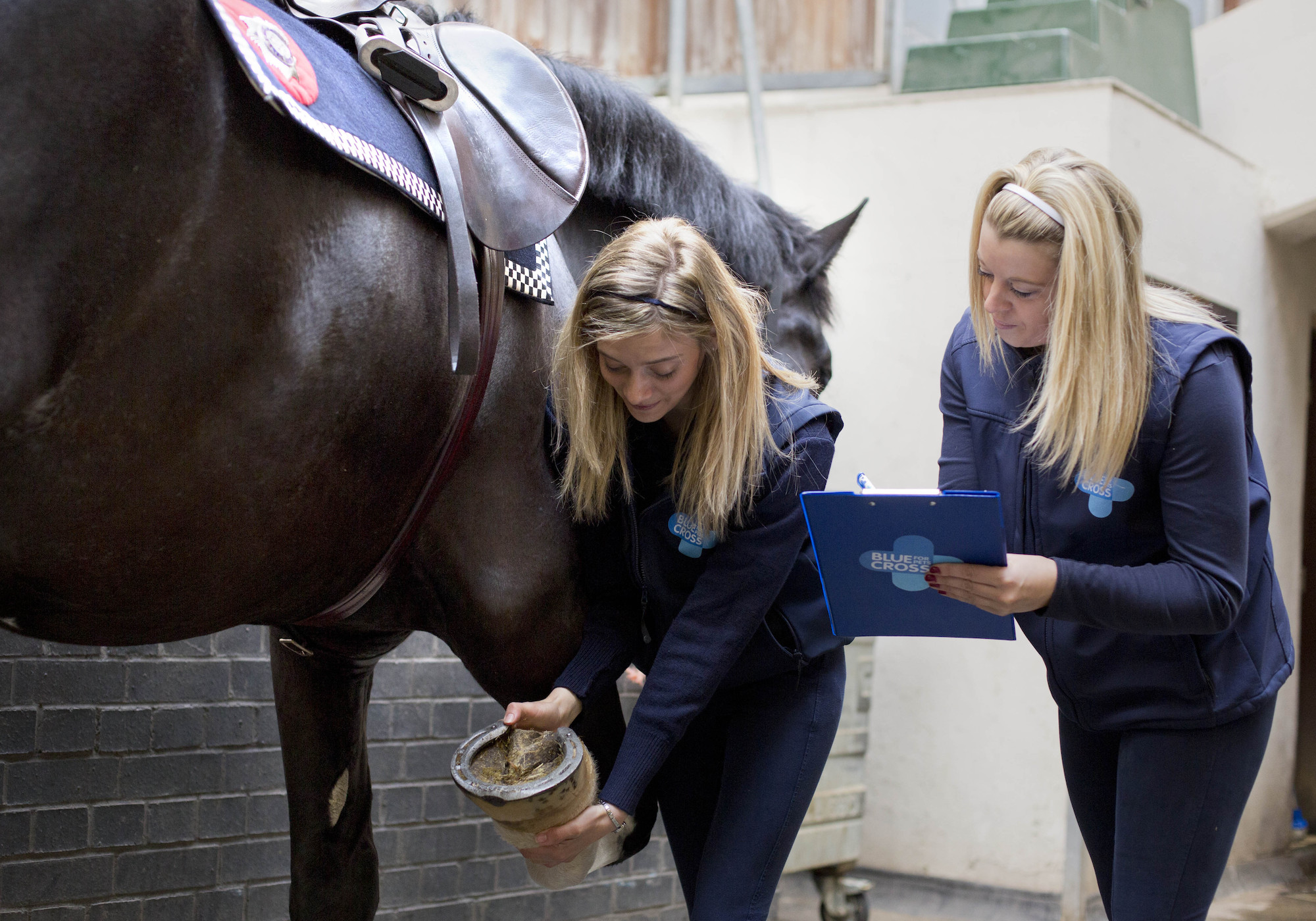
Daily health checks for your horse
Daily health checks on your horse can help you to spot signs of injury or illness.
Daily health checks involve checking your horse's physical health for any abnormalities and monitoring their behaviour.
If you notice anything you that you’re not sure about during your horse’s daily health check, it’s a good idea to speak to your vet. Delaying treatment can make illnesses more difficult to treat.
Signs of a healthy horse
Before you start your horse's daily health check, it's a good idea to get to know the signs of a healthy horse, so you can compare this to your horse's current health. Signs of a healthy horse include:
- being alert and responsive to their surroundings
- interacting with their friends as usual
- walking and trotting freely, or moving around as normal
- bright and clear eyes
- a normal temperature, pulse and respiration rate (TPR)
- having a healthy appetite
- a shiny and smooth coat
- a healthy body condition
Taking your horse’s temperature, pulse and respiration rate (TPR)
Taking your horse’s TPR is an important part of their healthcare. Knowing their normal temperature, pulse (heart) and respiration (breathing) rate, will help you get to know when something is wrong.
If your horse is showing signs that their TPR is elevated, it’s important to take a reading. Signs of an elevated TPR include:
- breathing quicker than normal
- sweating
- depressed behaviour
What is a normal TPR for a horse?
It’s important to get to know your horse’s normal TPR while at rest, so you can compare this to their TPR when they are unwell. To know what your horse’s normal TPR is, you will need to take their readings over a course of three days, at the same time, while your horse is at rest. Then, you can take the average of the three readings and keep a record of them to refer back to if necessary.
- temperature: approximately 38°C (slight variations are normal)
- pulse rate: 36 to 42 beats per minute
- respiration rate: eight to 16 breaths per minute
Pulse and respiratory rates are likely to be higher in horses who are young (foals) or elderly horses.
Important
If your horse’s rates are abnormal and there's no reason for the change, such as recent stress or exercise, speak to your vet.
How to take your horse’s TPR
Your horse’s TPR should be taken while at rest.
Temperature
Your horse's temperature will need to be taken through their rectum with a digital thermometer.
- Ask someone to hold your horse to keep them calm while you take their temperature. You'll need to stand safely to the side of your horse, behind their hindquarters, to minimise the risk of getting kicked.
- Turn your thermometer on and check that the display is working as it should be
- Apply a generous amount of petroleum jelly to the end of the thermometer to make sure it's lubricated
- Gently move your horse's tail and insert the end of the thermometer into their rectum, angling it slightly so it touches the inside wall
- Hold the thermometer still for 15 seconds, or until it beeps to let you know that it has found a reading
- Check the reading and thoroughly clean the end of the thermometer ready for future use
Pulse (heart) rate
If you have a stethoscope, you can take your horse's heart rate by placing it just behind their left elbow so you can hear their heart. If not, you can take the same reading by finding their pulse:
- Ask someone to hold your horse to keep them calm and relaxed while you take their pulse
- Feel for your horse's pulse by finding their facial artery – this will be located just under their jawbone. You may need to gently apply pressure to be able to find it. To avoid feeling your own pulse, remember to use your fingers and not your thumb.
- Count the number of beats you can feel in 15 seconds using a timer
- Multiply this number by four to calculate your horse's pulse rate
Respiration (breathing) rate
When taking your horse's respiration rate, you are timing the amount of breaths they're taking each minute.
- Stand to the side of your horse, far enough away that you can watch their ribcage rise and fall
- Look for one inhale and exhale, or rise and fall of their ribcage – this equals one breath
- Count how many breaths your horse takes in 15 seconds using a timer
- Multiply this number by four to calculate your horse's breaths per minute
How to check your horse’s daily health
Daily health checks on your horse involve checking their physical health and observing their behaviour. This can be carried out while spending time with your horse.
Remember to make note of any changes in your horse’s health or behaviour, and speak to your vet as soon as possible if something is wrong.
Checking your horse’s health
When checking your horse’s health, you'll need to pay attention to your horse's:
Look out for any abnormalities or injuries on your horse's body. You can do this while grooming your horse, as this can help to build a bond, as well as maintain a healthy coat.
Your horse's coat should be smooth and shiny. A dull coat, missing patches of hair, damaged or dry, flaky skin, can indicate underlying skin conditions such as ringworm, mites, lice or rain scald. If your horse’s coat is raised and dull, this can also suggest that they are cold or feeling unwell.
Your horse's eyes should be bright and clear from any discharge. The skin around their eyes should also be pale pink.
They should not be swollen, glassy, cloudy, crusty or watery – these symptoms can point towards illnesses such as conjunctivitis (an infection in your horse's eye).
Your horse's nose should be clean and free of green or yellow discharge. Discharge coming from your horse's nose can be a symptom of equine flu or infection.
Their nose should also be soft and free from any cracks or dryness. Your horse's breathing should also be steady – you will be able to spot this by watching their nostrils flare. Consistent flaring can be a sign of breathing problems.
Most cases of lameness start in your horse's feet. Minor foot injuries can quickly get worse, so it's important to pick out and inspect your horse's feet as part of their daily routine.
When picking your horse's feet, remember to look out for:
- impacted stones, thorns or other foreign objects in your horse's hooves
- abnormal marks or patches of colour (red, purple or dirty black)
- unpleasant smell or discharge
- splits, cracks or other damage to the hoof wall, frog or bulbs of the heels
- twisted or loose shoes
Your horse should also have a normal stance without shifting their weight or resting a leg more than usual. If your horse is repeatedly shifting their weight, it can be a sign of laminitis.
Remember to also check your horse's legs by carefully running your hands up and down their legs, looking for injuries, swellings or heat.
Pay special attention to your horse's legs during wet weather, as mud fever can be a common cause of scabs.
Your horse should be eating normally with a healthy appetite. Quidding (dropping balls of partially chewed food) or a reluctance to eat, can suggest that your horse is suffering with their teeth.
Leaving their food, hay or haylage when they normally have a healthy appetite, can be a sign that your horse is feeling unwell.
Horses also normally drink between 25 to 55 litres of water each day. Keep an eye out for your horse drinking more or less than usual. This can be a sign that something is wrong.
It's normal for your horse to pass droppings every couple of hours. Droppings should be firm, although this may change slightly according to their diet, and covered with a mucus coating.
Extreme consistencies, such as being too runny or too hard, are not normal. Your horse should not have any difficulty passing their droppings – this can be an early sign of colic or other problems.
Your horse should also pass urine a couple of times a day. It should not be too dark in colour, too smelly, contain blood, or be difficult for your horse to pass.
Checking your horse's behaviour
Abnormal behaviour can often suggest that your horse is in pain or feeling unwell, so it's important to closely monitor your horse each day.
From afar, observe whether your horse is behaving like their usual self – this includes being alert, moving around as normal, being interested in their surroundings and interacting with their friends. You should also look out for any signs that indicate that something might be wrong, including:
- not interacting with you or greeting you as usual when they see you
- lying down more or less frequently, or lethargic behaviour
- abnormal behaviours such as box walking (repetitive pacing movements around their stable) or aggression
- changes in behaviour when riding, such as head shaking or reluctance to wearing the bit and bridle
If your horse has their head held low or pressed into a dark corner of their shelter or stable, with their ears clenched back, this may be a sign of illness or pain. If you notice any changes in your horse's behaviour, make a note and speak to your vet.
Other routine healthcare
Alongside daily health checks, there are other routine healthcare checks that should be completed throughout the year to keep your horse healthy. They include:
- farrier checks – usually every four to six weeks for shod feet, or six to ten weeks for unshod feet, depending on your individual horse or pony
- dental checks – a professional dental check every six to 12 months
- booster vaccinations – boosters for equine flu are needed every 12 months, and tetanus boosters are often only needed every two years
- worming – regular testing for worms throughout the year as part of their targeted worming programme
Page details
Reviewed
• 17 November 2023
Next review
• 17 November 2026





